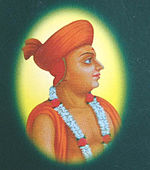- Muktanand Swami
-
Muktanand Swami (Devnagari: मुक्त्तान्द स्वामी)(1758-1830) was a sadhu and paramahansa of the Swaminarayan Sampraday.[1][2]
Contents
Biography
He was born Mukund Das to Anandram and Radhabai in Amreli, Gujarat in 1758. [3]
When children of his age group were indulging in sports, and games Mukund sat quietly in seclusion with the closed eyes. Mukund Das learnt Vedas, scriptures and music from two teachers - Jaduram and Hathiram, both of whom were scholars in literature and fine arts. [3]
Muktanand Swami was considered the principal disciple of Ramanand Swami. He mastered the eight folded yogic state. [4]
Swaminarayan and Muktanand Swami
In Loj, Sadhu Sukhanand a fellow saint and devotee residing at the hermitage found a young saint with divine aura bathing by a well near the village. Impressed by the sight of the divine attributes he took the young brahmchari to hermitage and introduced him to Muktanand Swami. Muktanand Swami found himself drawn towards the divine presence of the youthful saint and coming forward offered pranams. On a mutual introduction, Muktanand Swami gathered that the visitor was the son of DharmaDev and BhaktiDevi, and had spent seven years in the seclusion of the mountains and forests. His present name was Varniraj (forestdweller) Nilkanth Varni (Lord Swaminarayan). Nilkanth Varni stayed on in Loj to meet Ramanand Swami who was in Bhuj at that time. [5]
Satsang gives great importance to Muktanand Swami, because the foundation of this great sect was laid by him by closing interactive window between hermitage and neighbour, and separated women from the gents in Satsang Sabha on instance from Nilkanth Varni. [6]
He, though in age was senior to Nilkanth Varni (Renamed Sahajanand Swami by Ramanand Swami), but in succession to Ramanand Swami he proposed Sahajanand Swami as the successive preceptor and head of the sect. Thus Muktanand Swami lived under the auspices of Sahajanand Swami who always respected him like a Guru.[7]
Works
Muktanand Swami was instrumentalist and vocalist besides being a saint. He was equally at ease in dancing. Swaminarayan called him 'The mother of Satsang' because of his motherly love, tolerance and smooth interaction. He chose Muktanand Swami to represent the Swaminarayan Sampraday at the Gathering of Vadodara, where the latter was victorious.
Muktanand Swami has written a lot of poetry. He composed poems spontaneously. 'Mukund Bavani' is a collection of his devotional poetry. 'Muktanand Kavya' is the collection of his works. The Aarti that is sung in all Shri Swaminarayan Temple's, Jay Sadguru Swami was written by Muktanand Swami in praise of Shri Hari or Swaminarayan. [8] He has also written books on several subjects.
Notes
- ^ Behramji Merwanji Malabari, Krishnalal M. Jhaveri, Malabari M. B (1997), Gujarat and the Gujaratis, Asian Educational Services, ISBN 8120606515, http://books.google.com/?id=Lyd8jPbN218C&dq=muktanand+swami, retrieved May 7, 2009 Page 263 - 269
- ^ Williams 2001, pp. 189
- ^ a b Muktanand Swami, the mother of comunion, http://www.vadtal.com/our-saints-2.html
- ^ Williams 2001, pp. 75–77
- ^ Williams 2001, pp. 16
- ^ Williams 2001, pp. 15
- ^ Williams 2001, pp. 17
- ^ Williams 2001, pp. 76, 189
References
- Williams, Raymond (2001), Introduction to Swaminarayan Hinduism, Cambridge University Press, ISBN 9780521654227, http://www.amazon.com/dp/052165422X
External links
Swaminarayan Hinduism Major Groups Swaminarayan Sampraday (Vadtal Gadi and Ahmedabad Gadi) · BAPS · SMVS · Swaminarayan Gadi Sansthan · Gunatit Samaj ·

Major figures Swaminarayan (founder) · Muktanand Swami · Brahmanand Swami · Premanand Swami · Gopalanand Swami · Nishkulanand Swami · Gunatitanand Swami · Nityanand Swami
Scriptures and other books Devotional Songs Festivals Swaminarayan Sampraday Swaminarayan Temples
(Mandirs)
Establishments Major Deities Swaminarayan · NarNarayan · LaxmiNarayan · RadhaKrishna · Radha Ramana · Rama · Revati-Baldevji · Gopinathji Maharaj · Madan Mohan Dev · Hanuman · Ganpati · Shiva · Parvati · Suryanarayan
Noted Saints Muktanand Swami · Brahmanand Swami · Premanand Swami · Gopalanand Swami · Nishkulanand Swami · Gunatitanand Swami · Nityanand Swami
Scriptures and
other booksPresent Heads Acharya Shree Koshalendraprasadji Maharaj (Ahmedabad) · Acharya Shree Rakeshraprasadji Maharaj (Vadtal)
Devotional Songs Organisations International Swaminarayan Satsang Organisation · ISSO Seva · International Swaminarayan Satsang Mandal · NarNarayan Dev Yuvak Mandal · Swaminarayan GurukulCategories:- Swaminarayan sect of Hinduism
Wikimedia Foundation. 2010.

